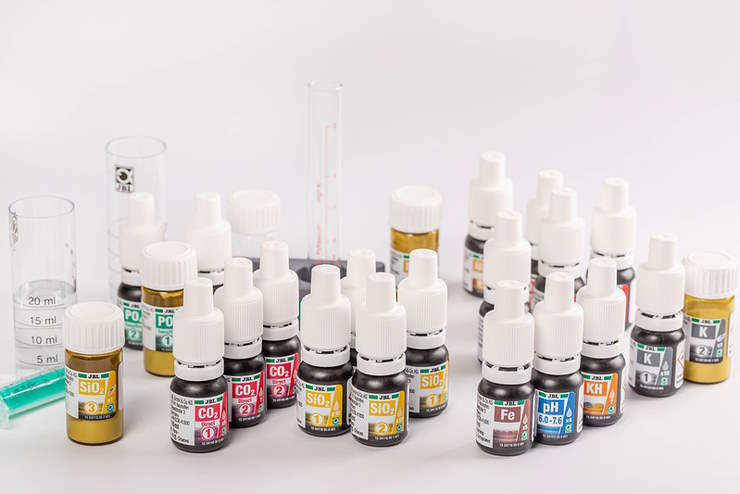Keeping fish is a rewarding hobby, but water quality concerns can be daunting. Testing water parameters, however, can be an enjoyable way to monitor the health of your aquarium inhabitants. Knowing which parameters are essential helps you focus on maintaining a healthy aquatic environment without getting overwhelmed.

This blog post will break down the essential water parameters into three categories: must-test, good-to-have, and less important. Let’s learn what each parameter means, why it’s important, and provide insights on managing them effectively.
1. Must-test aquarium water parameters
These are the most critical water parameters you need to monitor regularly to ensure a healthy environment for your fish.
- Ammonia (NH3):
- Ammonia is a toxic compound produced by fish waste, uneaten food, and decaying plant matter.
- High ammonia levels can cause stress, illness, and even death in fish.
- To manage ammonia levels, establish a healthy nitrogen cycle, avoid overfeeding, and perform regular water changes.
- Nitrite (NO2–):
- Nitrite is another toxic compound formed when beneficial bacteria convert ammonia during the nitrogen cycle.
- High nitrite levels can cause similar issues as ammonia, harming fish and other aquatic organisms.
- Keep nitrite levels in check by maintaining a healthy nitrogen cycle, avoiding overstocking your tank, and performing regular water changes.
- Nitrate (NO3–):
- Nitrate is the final product of the nitrogen cycle and is less toxic than ammonia or nitrite.
- However, high nitrate levels can lead to algae blooms, poor water quality, and long-term health issues in fish.
- Manage nitrate levels with regular water changes, proper aquarium maintenance, and live plants that absorb nitrates.
- pH:
- pH measures the acidity or alkalinity of your aquarium water.
- Different fish species have specific pH requirements for optimal health.
- Regularly monitor pH levels and adjust them with proper buffering agents or natural methods like driftwood and peat moss.
- Temperature:
- The temperature of your aquarium should be stable and within the preferred range for the species you’re keeping.
- Sudden temperature fluctuations can cause stress, illness, or even fish death.
- Use a reliable heater and thermometer to maintain a consistent water temperature.
2. Good-to-have parameters
These parameters aren’t as critical as the must-test parameters, but monitoring them can still contribute to a healthier aquarium.
- General Hardness (GH):
- GH measures the concentration of calcium and magnesium ions in the water.
- Fish and plants have specific GH requirements, affecting their growth, reproduction, and overall health.
- Adjust GH levels with water conditioners or use a mix of hard and soft water sources.
- Carbonate Hardness (KH):
- KH measures the alkalinity of your aquarium water, which helps stabilize pH levels.
- A proper KH level prevents sudden pH swings, which can be harmful to fish and plants.
- Manage KH levels with buffering agents, crushed coral, or limestone.
- Phosphate (PO4):
- Phosphate is a nutrient that can promote algae growth when present in high levels.
- Monitor phosphate levels to control algae blooms and maintain good water quality.
- Limit phosphate levels through regular water changes, phosphate-absorbing media, and avoiding overfeeding.
- Dissolved Oxygen (DO):
- Adequate oxygen levels are essential for fish respiration and overall health.
- Low oxygen levels can cause stress, illness, or death in fish.
- Ensure proper aeration, water circulation, and add live plants to maintain sufficient oxygen levels.
- Salinity (for saltwater tanks):
- Salinity measures the concentration of dissolved salts in your aquarium water.
- Proper salinity is crucial for the health of marine fish, invertebrates, and corals in saltwater tanks.
- Regularly monitor salinity using a hydrometer or refractometer and adjust levels as needed with the appropriate salt mix or freshwater top-offs.
3. Less Important Parameters
These parameters are not as vital to monitor regularly, but understanding their role in the aquarium can still be useful.
- Silicate (SiO2):
- Silicates are nutrients found in tap water, some substrates, and other aquarium materials.
- High silicate levels can promote the growth of diatoms, a type of algae.
- While not a primary concern, controlling silicates can help maintain a clean and algae-free aquarium. Use silicate-absorbing media if needed.
- Redox Potential (ORP):
- ORP, or Oxidation-Reduction Potential, measures the water’s overall balance of oxidizing and reducing agents.
- An optimal ORP level can indicate a healthy aquatic environment, but its significance in home aquariums is still debated.
- Monitoring ORP can provide useful information about water quality, but it is not as essential as other parameters for most home aquariums.
Conclusion
Regularly testing your aquarium water is essential to maintaining a healthy environment for your aquatic pets.
By understanding and monitoring critical parameters like ammonia, nitrite, nitrate, pH, and temperature, you can ensure optimal conditions for your fish and plants.
Additional parameters, like GH, KH, phosphate, and dissolved oxygen, can provide valuable insight into your aquarium’s overall health, while less important parameters like silicate and redox potential can be useful in specific situations only.
Stay diligent in your testing and maintenance routines, and your aquarium will thrive with happy, healthy inhabitants. Remember to keep learning and refining your skills as an aquarist to ensure the long-term success of your aquarium.
Leave a Reply